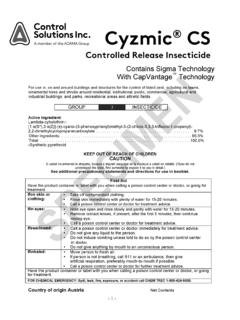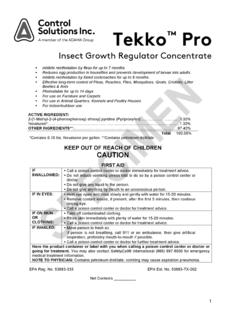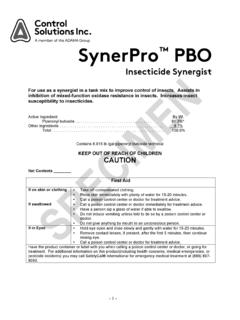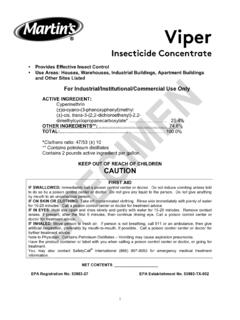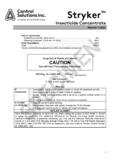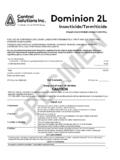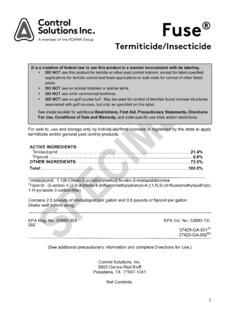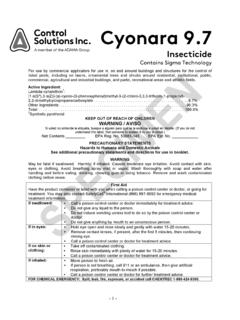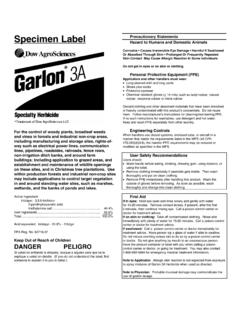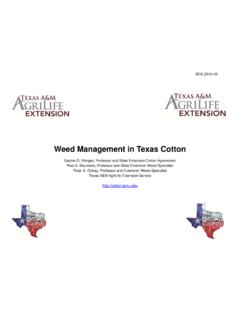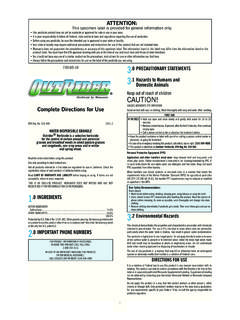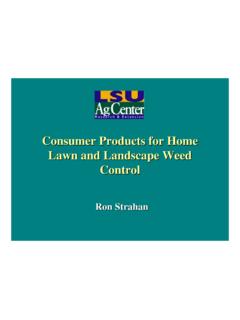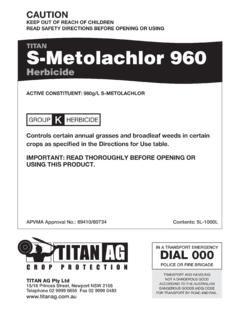Transcription of Selective Broadleaf Weed Control in Turfgrasses …
1 Specimen Label 2DQ Herbicide Selective Broadleaf Weed Control in Turfgrasses Including Use on Golf Courses and Sod Farms. To Control Clover, Dandelion, Henbit, Plantains, Wild Onion and Many Other Broadleaf Weeds. Also for Highways, Rights-of-Way, and Other Similar Non-Crop Areas as Listed on This Label ACTIVE INGREDIENTS: % BY WT. *Dimethylamine Salt of 2,4-Dichlorophenoxyacetic acid .. **Dimethylamine Salt of Dicamba (3,6-dichloro-o-anisic acid) .. **Quinclorac: 3,7-dichloro-8-quinolinecarboxylic acid .. OTHER INGREDIENTS: .. TOTAL: Contains: * Ibs. 2,4-Dichlorophenoxyacetic acid per gallon or ** Ibs. 3,6-dichloro-o-anisic acid per gallon or ** lbs. 3,7-dichloro-8-quinolinecarboxylic acid or KEEP OUT OF REACH OF CHILDREN DANGER PELIGRO See inside booklet for additional Precautionary Statements and Directions for Use.
2 Si usted no entiende la etiqueta, busque a alguien para que se la explique a usted en detalle. (If you do not understand the label, find someone to explain it to you in detail.) Manufactured for: 5903 Genoa-Red Bluff Road Pasadena, Texas 77507 EPA Reg. No. 53883-334 EPA Est. No. xxxxxx NET CONTENTS: ____ GALS 2DQ Specimen Label Page 2 of 10 FIRST AID IF IN EYES: Hold eye open and rinse slowly and gently with water for 15 to 20 minutes. Remove contact lenses, if present, after the first 5 minutes; then continue rinsing eye. Call a poison Control center or doctor for treatment advice. IF ON SKIN OR CLOTHING: Take off contaminated clothing. Rinse skin immediately with plenty of water for 15 to 20 minutes. Call a poison Control center or doctor for treatment advice.
3 IF SWALLOWED: Call a poison Control center or doctor immediately for treatment advice. Have person sip a glass of water if able to swallow. Do not induce vomiting unless told to do so by a poison Control center or doctor. Do not give anything by mouth to an unconscious person. IF INHALED: Move person to fresh air. If person is not breathing, call 911 or an ambulance; then give artificial respiration, preferably mouth-to-mouth if possible. Call a poison Control center or doctor for further treatment advice. Have the product container or label with you when calling a poison Control center or doctor or going for treatment. You may also contact SafetyCall International (866)897-8050 for emergency medical treatment information. Note to Physician: If in eyes, specialized ophthalmologic attention may be necessary. If swallowed, probable mucosal damage may contraindicate the use of gastric lavage.
4 There is no specific antidote; treat symptomatically. PRECAUTIONARY STATEMENTS HAZARDS TO HUMANS AND DOMESTIC ANIMALS DANGER - PELIGRO Corrosive. Causes irreversible eye damage. Harmful if swallowed or absorbed through skin. Avoid contact with skin. Do not get in eyes or on skin or clothing. PERSONAL PROTECTIVE EQUIPMENT (PPE) Some materials that are chemical resistant to this product are barrier laminate, nitrile rubber, neoprene rubber, or Viton. All mixers, loaders, applicators, and other handlers must wear: Long-sleeved shirt and long pants Shoes plus socks Protective eyewear (goggles, face shield, or safety glasses) Chemical-resistant gloves. Chemical-resistant apron when mixing or loading, cleaning up spills or equipment, or otherwise exposed to the concentrate See ENGINEERING CONTROLS for additional requirements.
5 Follow manufacturer's instructions for cleaning/maintaining PPE. If no such instructions for washables exist, use detergent and hot water. Keep and wash PPE separately from other laundry. Discard clothing and other absorbent materials that have been drenched or heavily contaminated with this product s concentrate. Do not reuse them. ENGINEERING CONTROLS When handlers use closed systems or enclosed cabs, in a manner that meets or exceeds the requirements listed in the Worker Protection Standard (WPS) for agricultural pesticides [40 CFR (d)(4-6)], the handler PPE requirements may be reduced or modified as specified in the WPS. 2DQ Specimen Label Page 3 of 10 USER SAFETY RECOMMENDATIONS Users should: Wash hands, face and arms thoroughly with soap and water before eating, drinking, chewing gum, using tobacco, or using the toilet.
6 Remove clothing/PPE immediately if pesticide gets inside. Then wash thoroughly and put on clean clothing. If pesticide gets on skin, wash immediately with soap and water. Remove PPE immediately after handling this product. Wash the outside of gloves before removing. As soon as possible, wash thoroughly and change into clean clothing. Discard clothing and other absorbent materials that have been drenched or heavily contaminated with this product s concentrate. Do not reuse them. Remove and wash contaminated clothing before reuse. ENVIRONMENTAL HAZARDS This product is toxic to fish and aquatic invertebrates and may adversely affect nontarget plants. Do not apply directly to water, to areas where surface water is present, or to intertidal areas below the mean high water mark. Drift and runoff may be hazardous to aquatic organisms in water adjacent to treated areas.
7 Do not contaminate water when disposing of equipment washwaters or rinsate. This product has properties and characteristics associated with chemicals detected in groundwater. The use of this chemical in areas where soils are permeable, particularly where the water table is shallow, may result in groundwater contamination. Application around a cistern or well may result in contamination of drinking water or groundwater. Groundwater Contamination: Most cases of groundwater contamination involving phenoxy herbicides have been associated with mixing/loading and disposal sites. Caution should be exercised when handling 2,4-D pesticides at such sites to prevent contamination of groundwater supplies. Use of closed systems for mixing or transferring this pesticide will reduce the probability of spills.
8 Placement of the mixing/loading equipment on an impervious pad to contain spills will help prevent groundwater contamination. DIRECTIONS FOR USE It is a violation of Federal law to use this product in a manner inconsistent with its labeling. Read the entire label before using this product. Use strictly in accordance with the label precautionary statements and directions. For use in New York State by spot treatment only. Spray only the weed not the entire lawn. This product is for use on ornamental turf lawns (residential, industrial, and institutional), parks, cemeteries, athletic fields, golf courses (fairways, aprons, tees, and roughs), and similar turf areas. Also for use on sod farms. Use of this product in certain portions of California, Oregon, and Washington is subject to the January 22, 2004 Order for injunctive relief in Washington Toxics Coalition, et.
9 Al. v. EPA, C01-0132C, ( WA). For further information, please refer to Do not apply this product in a way that will contact any person or pet either directly or through drift. Only protected handlers may be in the area during application. For any requirements specific to your State or Tribe, consult the agency responsible for pesticide regulation. 2DQ Specimen Label Page 4 of 10 AGRICULTURAL USE REQUIREMENTS Use this product only in accordance with its labeling and with the Worker Protection Standard, 40 CFR Part 170. This Standard contains requirements for the protection of agricultural workers on farms, forests, nurseries, and greenhouses, and handlers of agricultural pesticides. It contains requirements for training, decontamination, notification, and emergency assistance. It also contains specific instructions and exceptions pertaining to the statements on this label about personal protective equipment (PPE) and restricted-entry intervals.
10 The requirements in this box only apply to uses of this product that are covered by the Worker Protection Standard. Do not enter or allow worker entry into treated areas during the restricted-entry interval (REI) of 48 hours. PPE required for early entry to treated areas that is permitted under the Worker Protection Standard and that involves contact with anything that has been treated such as plants, soil, or water is: Coveralls over short-sleeved shirt and short pants Chemical-resistant gloves made of any waterproof material Chemical-resistant footwear plus socks Protective eyewear (goggles, face shield, or safety glasses) Chemical-resistant headgear for overhead exposure NON-AGRICULTURAL USE REQUIREMENTS The requirements in this box apply to uses of this product that are NOT within the scope of the Worker Protection Standard for agricultural pesticides (40 CFR Part 170).
